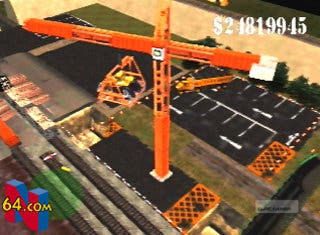Retrospective: Blast Corps
Dozy blastard.
J-Bomb-centric stages are overwhelmingly simple fare, and fly in the face of Hocking's decade-later judgment. As a giant robot (J-Bomb, not Hocking, though I've never seen them in the same room...), he can launch into the sky on an infinitely-fuelled jetpack, before stabbing back down, storey-sized-feet first, totally obliterating anything in his path. Skyscrapers are levelled, disintegrated; smaller obstacles are nothing. For an interlude, it's superb; you're Godzilla, swatting puny high-rises aside, multi-coloured explosions and a score for damage caused endlessly turning as simple motions rack up the score. Jump, smash, rinse, repeat.
It's game wish-fulfilment of the highest order. It's what we say we want: spectacle, simplicity, feedback. The combination developers have been trying to brew since the 1970s, the sugar rush of arcade achievement and enjoyment. But, like most quick fixes, it doesn't last forever.
I found, cherrypicking J-Bomb-heavy levels again on a recent playthrough, that I'd lost a handle on what it was that tied me to the game so strongly in the first place. Was 12 years too far back? What was the spark that linked it so intrinsically to my time with the Nintendo 64, and my childhood?
Flicking through the game's level-select hub, two names hit me, names that produced a near-physical response. A twitch, an involuntary jerk away from the pain they had associated with them: Oyster Harbour, and Diamond Sands. Oh God. Oh no.

For a certain generation of gamers, I'm fairly sure these levels will have a similar effect. The innocently named stages in question were, in truth, no more fiendish than some of the game's other offerings, but came to stand in unison for Blast Corps unwavering commitment to incredible frustration.
Oyster Harbour first. To explain exactly the machinations necessary to actually finish the level is a task that I have neither the word count nor the mental fortitude to complete - many of the century's greatest minds have no doubt been irrecoverably smashed attempting to do so. Suffice to say, to pass the nuclear carrier across the first of the Harbour's three major sections, players must judge the arc necessary to fire rockets into a mass of stacked crates, negotiate a cliffside path, jump in a bulldozer to mop up remaining obstacles, use said bulldozer to load crates of TNT (on a timed fuse) onto a crane, then finally, before detonation, operate the crane, dropping several explosive boxes onto an inconveniently placed wharf. That's before you've got the canal boats involved.
Men of Eurogamer - if you're ever accused directly of your genders' inability to multi-task, I implore you - find a copy of Blast Corps, finish Oyster Harbour, and display the medal you receive with proud tears streaming down your cheeks. To keep track of every possible variable in the level while simultaneously acting with enough of a sense of wild abandon to keep a step ahead of the onrushing nuclear lorry is an ability probably likely to land you a role in the air-forces of most major countries. It's indicative of how fiendishly far the developers could go with Blast Corps' innocuous setup, layers piled on layers as one misstep spells disaster, and in my case, broken controllers.